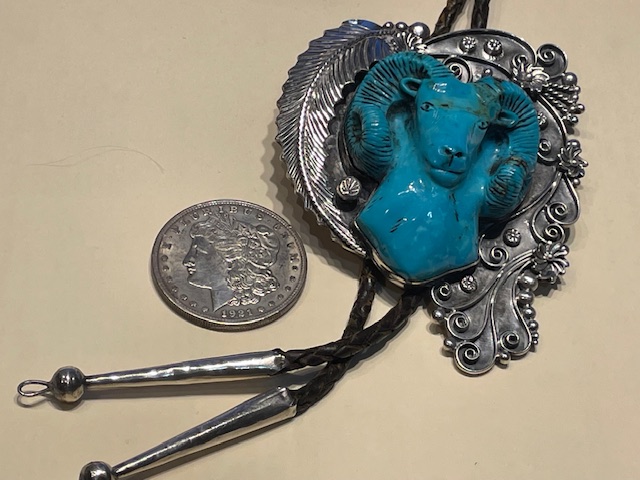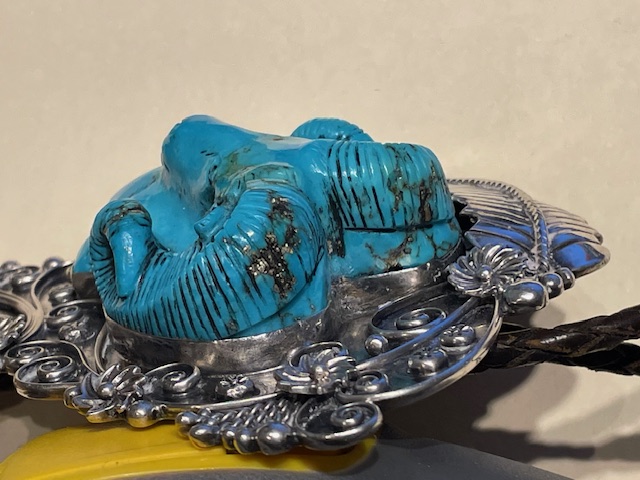

I love it. The carving is so detailed.
Hope someone can help with the Hallmark, if needed.
I was also wondering about the turquoise source. One hint is the surprisingly vivid pyrite matrix visible in the ram’s left horn. Also, regarding the hallmark, the BP’s in more of the books (Piaso, Pinto, etc.) do not use the stylized “B” or “P.” The curves in the B and P look almost like horseshoes placed laterally.
Is it usual for Native American silversmiths to have their mark on a raised piece like this little circle (not sure of the correct name in the jewellery trade although I’ve heard it called a cartouche)?
Occasionally they do. I have a ring by Bobby Shack and he does this, although it’s in a rectangle.
In my experience, they are rather uncommon. But I have seen two or three, and I believe they were on larger pieces.
5th edition cites
plate
raise plate
applied plate
oval plate
fringed plate
clipped plate
square plate
rounded plate
not unusual
Although, perhaps to Chamekke’s point, Bobby Shack is Zuni

Okaaaay…I was just pointing out it can be a thing.
Sorry Steve, I’m new here. 5th edition what? My sources are: Alain, webmaster@art-amerindien.com, Barton Wright’s Hallmarks of the Southwest, and Schaff’s American Indian Jewelry.
I’d love to know of other studies and resources.
Ziacat, sorry if I offended. I thought that the discussion had moved, implicitly, to a question of whether Navajo’s, per se, were using such a plate, as opposed to other tribes. So that, by extension, perhaps BP’s use of the plate suggests he might not have been Navajo…
No worries. Nope, I just meant in general. Your piece appears to be Navajo. With the pyrite, maybe Kingman?
Ah, thanks for the Kingman suggestion.
Thank you for this list! I love learning the terminology and the different variations this can take.
Of course there are other mines that produce turquoise with pyrite, but guessing Kingman (because there is so dang much of it) is often the default when the mine is unknown.
Many thanks, Steve! I just read that the Kingman mine occasionally produces turquoise in a silver matrix. Wonder if the bright metal of my BP ram horn might actually be silver?
While the Turquoise is of US origin, the carving is likely Philippine. The silver work is likely from the Philippines as well.
in the late 70’s a fellow by the name of Dave Freeland established a shop in the Philippines which produced elaborate detailed turquoise carvings set in Navajo style silver work created by Philippine crafts people. His shop also produced an extensive line of imitation Zuni jewelry which he marketed world wide.
As far as I know, the shop or an evolved version of it is still active in the Philippines and producing carvings, inlay and jewelry.
It does look like Kingman, Ziacat. Freeland used huge quantities of treated Kingman turquoise in his Philippine made jewelry lines. Some of the carvings are absolutely enormous, and incredibly detailed.
hmmm. Interesting opinion. The antique dealer, my source for that piece, had owned it for 20 years when I bought it in 2000, and he had acquired it as “old pawn” in about 1980 in the Four Corners area. The Freeland pieces that I can see online now–from either Freeland the elder, or Freeland Jr.–bear none of the characteristics of my ram bolo. And it appears Freeland uses his own hallmark, “DRF.”